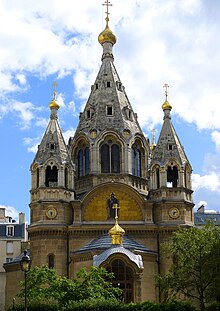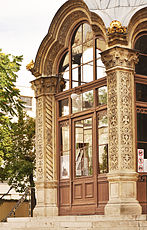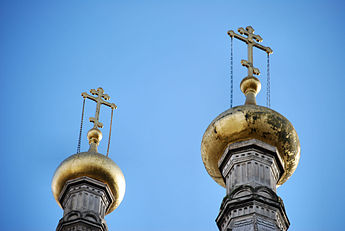Alexander Nevsky Cathedral, Paris
| Alexander Nevsky Cathedral | |
|---|---|
| Cathedral of Saint Alexander Nevsky | |
Cathédrale Saint-Alexandre-Nevsky de Paris | |
 | |
| 48°52′39.3″N 2°18′7.1″E / 48.877583°N 2.301972°E | |
| Location | Paris |
| Country | France |
| Denomination | Russian Orthodox Church |
| Website | cathedrale-orthodoxe.com |
| History | |
| Founder(s) | Joseph Vassiliev, Alexander II of Russia |
| Consecrated | 11 September 1861 |
| Architecture | |
| Heritage designation | |
| Designated | 11 May 1981 |
| Architect(s) | Roman Kouzmine, Ivan Strohm |
| Architectural type | Cathedral |
| Style | Byzantine |
| Groundbreaking | 3 March 1859 |
| Administration | |
| Archdiocese | Patriarchal Exarchate for Orthodox Parishes of Russian Tradition in Western Europe |
| Clergy | |
| Archbishop | John of Dubna |
The Alexander Nevsky Cathedral (French: Cathédrale Saint-Alexandre-Nevsky, Russian: Собор Святого Александра Невского, romanized: Sobor Svyatogo Aleksandra Nyevskogo) is a Russian Orthodox cathedral church located at 12 Rue Daru in the 8th arrondissement of Paris. The closest métro station is Courcelles ![]()
![]() .
.
History
[edit]The first Russian Orthodox church in Paris was a small oratory constructed on Rue de Berri in 1816. As the population of Russian immigrants in Paris grew during the 19th century, a larger church was needed. In 1847, the chaplain of the Russian Embassy in Paris, Father Joseph Vassiliev, received permission from Emperor Napoleon III to construct a larger church. The program was moved forward by a grant of 200,000 French francs from Czar Alexander II, whose patron saint was Alexander Nevsky (1219-1263) Nevsky had contributed to the unification of Russia as well the establishment of the Russian Orthodox church throughout the Russian empire.[2]

Work on the church began in 1859 under Roman Kouzmine, chief architect of the Russian imperial Court, and the chef engineer Strohm. The cathedral was established and consecrated in 1861, making it the first Russian Orthodox place of worship in France.[3]
The church was formally given cathedral status in 1951. During the Soviet period, it was the headdquarters of an archbishop who supervised the other Russian Orthodox churches in Western Europe. Following the downfall of the Soviet Union, the church was returned to jurisdiction of the Ecumenical Patriarchate of Constantinople, established in 1931, located in Istanbul. The cathedral became the see of the Archdiocese of Russian Orthodox Churches in Western Europe.[4]
It should not be confused with Holy Trinity Orthodox Cathedral, which is a provincial cathedral of the Patriarchal Exarchate in Western Europe (Moscow Patriarchate).
Exterior
[edit]
The exterior of the church is a good example, of what its builder, the Russian diplomat to France Joseph Valliliev, called "Byzantine Muscovite". It used the Byzantine form of Greek cross and a semi-circular fronton with a mosaic image of Christ giving a blessing. The distinctly Russian element was the group of five bell towers which symbolised Christ and the four evangelists. The towers are topped with gilded bulblike domes, which symbolise the flames of candles carried by the worshippers, which lift their prayers to heaven. The central tower is topped by a Russian Orthodox cross, and has three traverses, representing Christ and the four evangelists.[5]
The church is supported by a crypt, known as the "Lower Church". dedicated to the Holy Trinity, In 1963 the crypt became the official place of worship of the Russian Orthodox Church in France.[6]
Associated notable people
[edit]- Nikolai Aleksandrovich Semashko, the first People's Commissar for Health of Soviet Russia, married Nadezhda Mikhailovna Nelidova (née Sokol’skaia) here on 13 August 1909.
- Gabriel Attal, prime minister of France, attended services as a child.
- Artist Pablo Picasso married Olga Khokhlova here on 12 July 1918; the witnesses were Jean Cocteau, Max Jacob, and Guillaume Apollinaire.
- Henri Troyat’s first marriage was conducted here in 1938.
- Former world chess champion Vladimir Kramnik married here in 2006.
- The funerals of several noted Russian artists, writers, and other cultural figures were held here: Ivan Turgenev in 1883, Fyodor Chaliapin in 1938, Wassily Kandinsky in 1944, George Gurdjieff in 1949, Ivan Bunin in 1953, Andrei Tarkovsky in 1987, and Henri Troyat in 2007.
- Alexander Schmemann, noted Russian theologian and writer, and future dean of St. Vladimir's Orthodox Theological Seminary (1962-1983) in New York, served here as an altar boy and sub-deacon in the 1930s.
- Vassily Voskresensky aka Colonel Wassily de Basil, impresario of the Ballets Russes de Monte Carlo (and its iterations) was buried here in 1951.
Representation in other media
[edit]The 1956 film Anastasia, about one of the daughters of the imperial Romanov family, features the Cathedral in one of its first scenes.[7]
Gallery
[edit]
Bibliography
[edit]- Dumoulin, Aline; Ardisson, Alexandra; Maingard, Jérôme; Antonello, Murielle; Églises de Paris (2010), Éditions Massin, Issy-Les-Moulineaux, ISBN 978-2-7072-0683-1
- Nicolas Ross, Saint-Alexandre sur-Seine, édition du CERF.
References
[edit]- ^ Base Mérimée: Cathédrale orthodoxe Saint-Alexandre-Nevsky, Ministère français de la Culture. (in French)
- ^ Dumoulin (2010), "Eglises de Paris" (in French) pp. 18–22
- ^ Hassell, James E. (1991). Russian Refugees in France and the United States Between the World Wars. American Philosophical Society. ISBN 978-0871698179.
- ^ "Historic and festive Sunday at St. Alexander Nevsky Cathedral". Exarchat. Archived from the original on 2020-12-29. Retrieved 2019-09-26.
- ^ Dumoulin (2010), "Eglises de Paris" (in French) pp. 18–22
- ^ Dumoulin (2010), "Eglises de Paris" (in French) pp. 18–22
- ^ "Anastasia". Turner Classic Movies.
- Eastern Orthodox church buildings in Paris
- Archdiocese of Russian Orthodox churches in Western Europe
- 1861 establishments in France
- Religious organizations established in 1861
- Buildings and structures in the 8th arrondissement of Paris
- Russian Orthodox cathedrals in France
- Byzantine Revival architecture in France
- Alexander Nevsky cathedrals
- Cathedrals in Paris
- 19th-century Eastern Orthodox church buildings
- 19th-century churches in France







